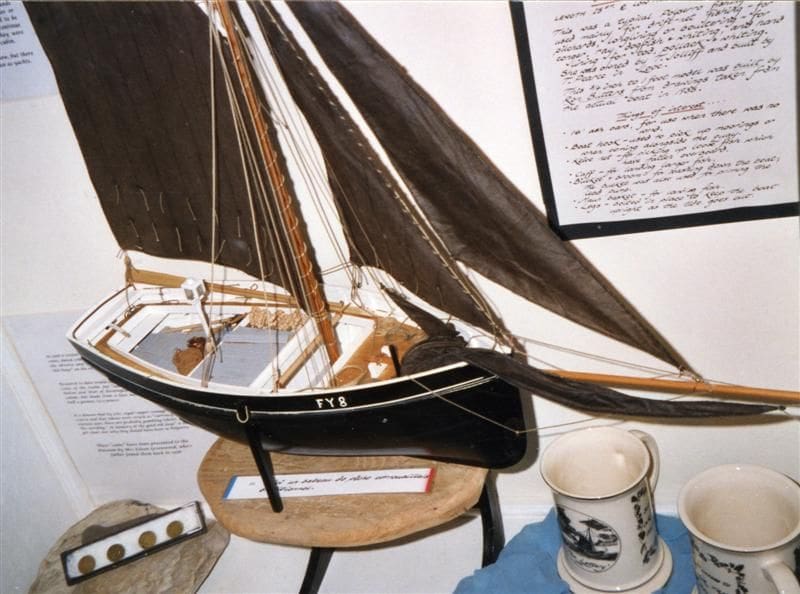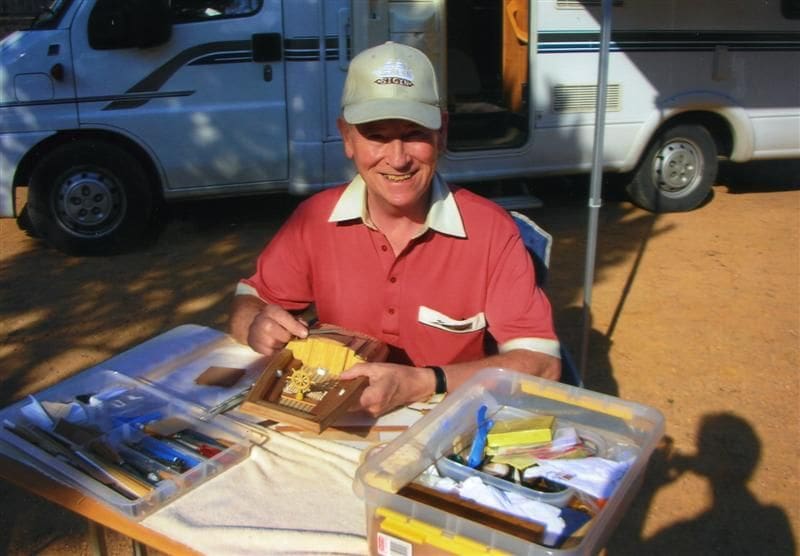ANTHONY ADDAMS gives us some background on the life and techniques of the hardy men who went to sea in Gaffers
 [header].jpg)
Photo 1
At the November 2008 Warwick International Model Boat Exhibition there was considerable interest shown in my miniature model of a Polperro Gaffer, so as a consequence………
Introduction
Enjoy more Model Boats Magazine reading in the monthly magazine.
Click here to subscribe & save.
The March 2008 issue of MB described the method of building this model, Photo 1, by means of a 16 layer bread and butter construction. The effect of so many layers gives the impression of the model being planked. The model is only 5 1/2 inches long and is set on a stand giving the impression of being alongside a quayside. At the exhibition and previously from the article in MB, several model makers have asked for plans which I have been pleased to forward. This article is now about how these boats came to be in Polperro, Cornwall and how they were used. The story starts with a great storm, and for anyone interested, Cornwall has been struck by storms of such ferocity that they can be researched on the internet. At least one was a tsunami that also destroyed Lisbon.
Gaffer fishing boats
Imagine it is 1891 in Polperro and the morning after the great storm and sea surge when the howling onshore gale pushed the high tide ten to fifteen feet above the usual highest water level and the great waves broke over the 90ft craggy rock known as ‘The Peak’ to the west of the harbour entrance. The force of wind and waves caused havoc inside the harbour. You have been up all night, are now exhausted, wet, tired and in the first light of day you view the devastation as the storm abates in the morning.
You see smashed boats piled far up Lansallos Street. They are mixed up with seaweed, shingle, sand, spars and nets, so you also realise all the boats are beyond repair. Many of the houses have been flooded up to their ceilings making them unsafe, so you see the shock and despair on the faces of your neighbours. They and you are beginning to worry about what the future holds. The great storm indeed destroyed the fishing fleet. The large open sailing clinker built luggers that had been the typical fishing boats were all destroyed. Gradually, out of this great disaster, the town’s fishing industry had to recover as the principle means of income and employment. For this, new boats were ordered and the ‘Gaffer’ was born. Unlike the previous open undecked clinker built hulls where each plank overlapped the next being roved, (riveted) together, the new boats were carvel built. In this form of construction, from a strong keel, timbers or ribs as in a skeletal rib cage were built up. Then the outer skin of planks, shaped to fit flush, were attached to form a strong smooth hull of great strength. Added rigidity was also included with the provision of a deck around the sides, bow and stern. Constructed by Peter Ferris and other yards at Looe with a length of about 25ft, the new design was unique to Polperro and quite different to the luggers fishing from Looe only five miles away. The new boats which cost £42 plus £10 for sails and £2-10s-0d (£2.50p) for each net, were called gaffers because unlike luggers, they were gaff rigged. The gaff is the heavy spar hauled up the mainmast to hold the top of the mainsail, at an angle of about 45 degrees. This arrangement provides a large sail area, on a relatively short mast. Often, once at the desired fishing ground, the boats would lower the gaff and mainsail to allow the boat to drift quietly or to anchor. Under these conditions, a short mast minimises the rolling of the boat in the sea swell as the pendulum effect of the short mast has much less effect than that of a much taller and therefore heavier mast. The new design included a small cuddy or cabin under the foredeck in the bows, with a stove for warmth and cooking. The boats often sailed out of Polperro at 6pm, staying out all night and sometimes for several days. The gaffer represented a great improvement on the previous open luggers.
My own interest in these boats was kindled when visiting the excellent Polperro Heritage Museum where a range of superb model fishing boats including gaffers and luggers are beautifully displayed.
The arrangement of decking, fish hold, helmsman’s position, sail plan and long retractable bowsprit can all be seen on the model. There was no boom on the foot of the mainsail, so the crew avoided being hit on the head when the sail came across for tacking. For comparison with my model, here is a real gaffer in Polperro, Photo 2. My model is based on one called Lilly and here is John Rowett Curtis who owned this boat, Photo 3. John eventually sold Lilly for £25. The new owner converted her to a habitable yacht, sailing her in 1948 across the Atlantic through the Panama Canal and then on to Alaska and back.
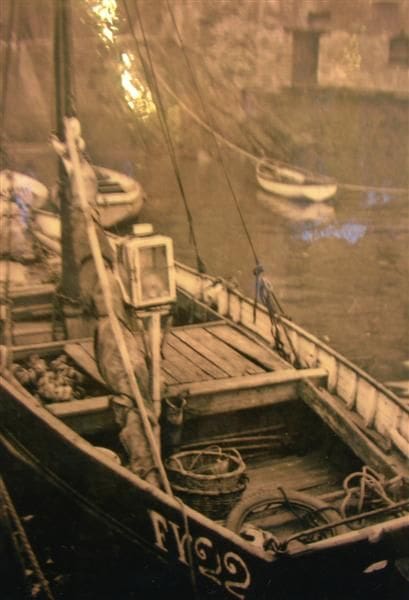
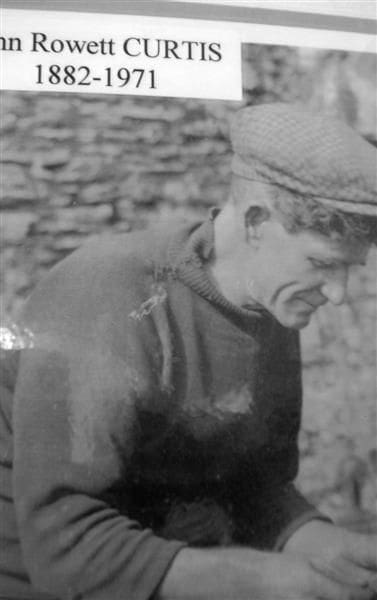
The fishermen
The fishermen knew the bottom of the sea almost as well as farmers knew the fields ashore. The noting of particular landmarks such as a prominent church tower, tall tree, white house or some distinctive rocks, enabled a fisherman to mentally fix the location of particular fishing grounds. The sea bed hills and valleys, crags and gullies of weed and sand with each having its particular fish, were known from long experience passed down the generations. Many special fishing grounds had names of ancient origin and might be as much as 35 miles away from Polperro. The prosperity of a successful fisherman depended on the accuracy of such knowledge. Added to this of course was the skill of judging the weather, the season, the habits of the fish, the appropriate nets and methods, the tide and currents, crew skills and stamina, market prices for types of fish and the handling of the boat with the ever present risk of an accident. As we have seen, a great storm could and did destroy it all in one night. Photo 4 shows fishermen hard at work.
The fishermen were a hardy race, but earnings at all times were precarious. The weather could restrict fishing and the 1868 records show there were 107 days when the fleet could not put to sea. Wives and children were involved in the work as well. Growing potatoes and vegetables on the hillside, mending the nets, making clothes, collecting firewood, cooking and minding the home were all essential to family survival. Added to all this was the task of selling the fish catch at the market on the Strand. There was also the industry of salt curing pilchards into 50 gallon casks known as hogsheads, each weighing 476 lbs. for export to Italy and elsewhere. Finally, the fish oil extracted in the process provided many uses including lighting and the production of a paint for external use.
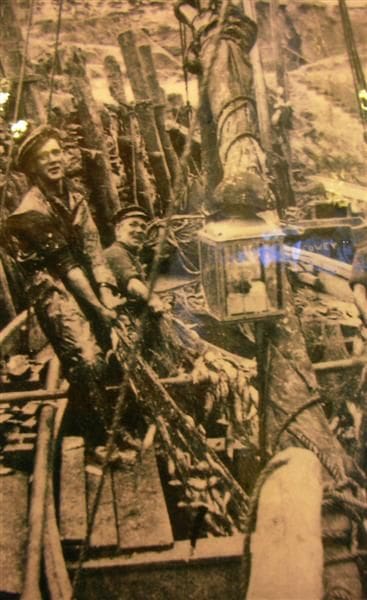
The fishing
A wide variety of fish were caught using baited lines, trawl nets, pots and other methods. Depending on the season, there were cod, whiting, mussels, pilchards, squid, conger eels, dory, crabs, turbot and brill. The boats were also used for collecting seaweed for fertilizing the land.
At the peak of the fishing industry some 50 gaffers operated from Polperro such that the harbour was crammed full of boats, Photo 5. It took great skill to sail into the harbour avoiding the treacherous rocks, negotiate the narrow entrance and then mooring without causing any disturbance to your friends, as they watched with a critical eye.
The really big catches of pilchards were made by the method of seaning under the direction of a master seaner who was hired by the fishermen of the village. Teamwork was of the essence, with the master on the cliff top directing the operation and below, two large boats loaded with large nets 1200 ft long and one small boat. From his elevated position the master could see movement below the water surface indicating the presence of huge swarms of fish. When a shoal was spotted, the master would silently signal the two large boats to the best position where they would join their nets and then quietly and carefully they would pay out the nets to completely surround the whole shoal. The nets hung like a curtain 12 ft deep with floats at the top and weights at the bottom. The small boat would use oars to splash the water opposite the point where the nets were closing to stop the fish escaping. The nets were gradually tightened to enclose the fish and if possible the whole netted shoal was dragged into shallow water with a sandy bottom and then anchored. The bottom of the net was then closed to completely hold the fish. If all had gone well as many as 200 hogsheads of fish could be caught in the net. In Photo 6 there must be millions of fish, almost as if it would be possible to walk over the shoal. It is an old photo so please ignore the darkened sky.
The boats from the village would now surround the sean and literally scoop the fish out with baskets. Evidently if all was done quietly then the fish suffered little stress, which ensured the quality of the catch. The process of ferrying the pilchards in baskets back to the factory, now the Heritage Museum, would be regulated by the daily capacity of the factory to cure and pack the fish. It could take a week to empty the sean of live fish. Here is a closer view of gaffers in Polperro, Photo 7.
So now you are an expert on seaning! As the years went by the gaffers were fitted with motors. For some, this reduced their catch as the fish were scared away by the noise. By the 1950’s the gaffers were being converted into pleasure yachts and excessive fishing had reduced the fishing boats in Polperro to just the few motor boats you see today. As in may places, tourism has now become the main source of income for the village.
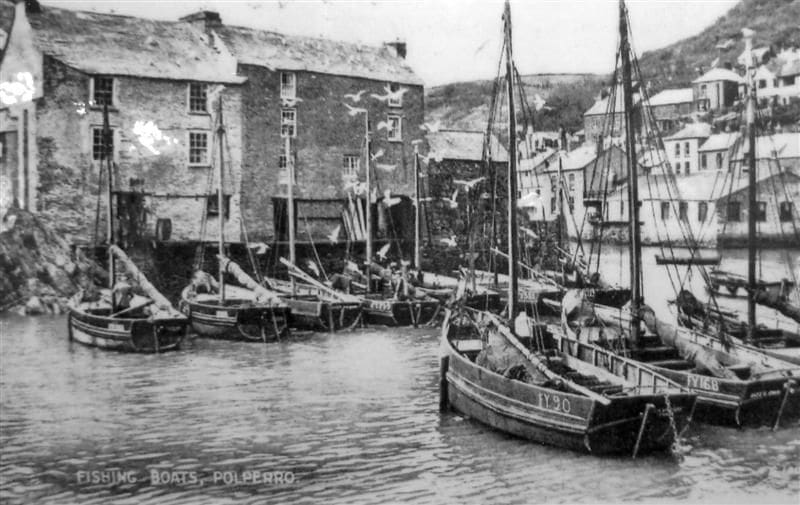
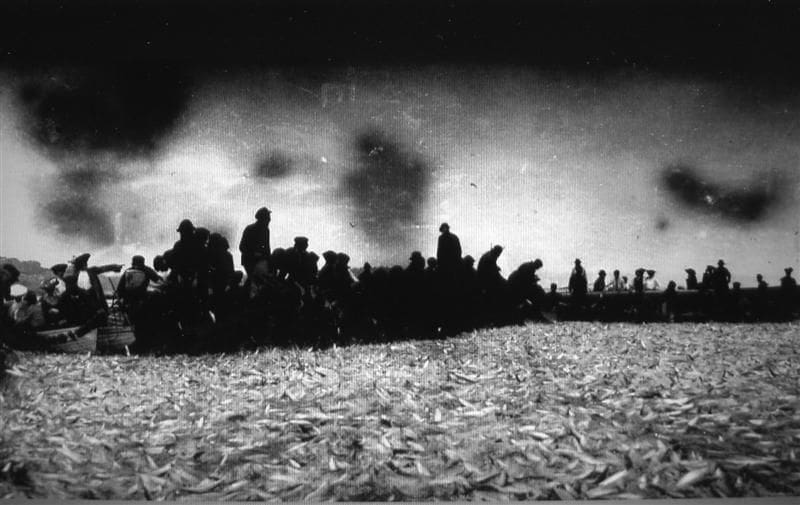
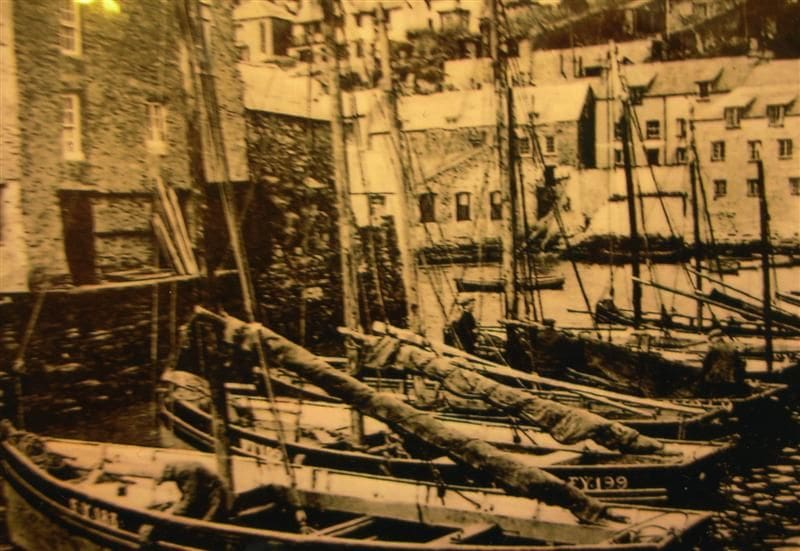
Conclusion
One of the superb models in the Heritage Museum is shown in Photo 8. Finally – why do I often build small models? Well, here in Photo 9 I am at work outside my motorhome in Spain. Space is limited, but I manage well with two plastic boxes (one on the table) for all my tools and materials for small models and a cardboard box for the model itself. It only takes five minutes to get it all out and the same again to put all away.
A word of caution though. As a result of applying some varnish to a model inside the motorhome one evening and not realising the strength of the fumes, I became very unsteady on my pins and was dreadfully ill that night. So, do take care and when it says: ‘Use in a well ventilated space – fumes may be dangerous to health’, then there is a good reason for it!
